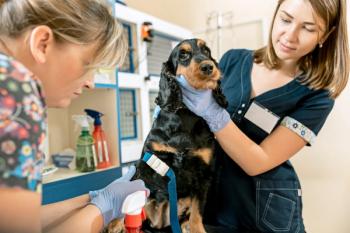
Can we quantify the true cost of veterinary student debt?
The burden of paying down student debt early in their careers plays a significant role in new graduates' lifestyle satisfaction.
Many veterinary students will tell you they've wanted to be a veterinarian since they were small children. Whatever persuaded them-a beloved pet, involvement in FFA or 4-H, or time spent shadowing a veterinarian-this profession has no lack of passion. Passion for the profession is what allows these students to look past the sacrifices and strenuous academic requirements necessary to pursue a veterinary degree.
The question we face now is whether those individuals know the true cost of these financial sacrifices. It's easy to look at a single summary dollar figure. But a dollar figure on paper doesn't capture what it means for you, your family or your day-to-day life. To that end, let's explore the similarities and differences between expenditure patterns of early-career veterinary households and the average U.S. family between the 70th and 80th percentiles of income using data collected from the American Veterinary Medical Association (AVMA) Personal Financial Planning (PFP) tool and from the Bureau of Labor Statistics (BLS).1
Comparing consumers' expenditure patterns to veterinarians' patterns
The mean household income reported by early-career veterinarians who used the PFP tool was similar to the mean income of the 70th to 80th percentile of Americans-roughly $85,000. The household expenditure data for Americans is from the BLS Consumer Expenditure Survey (CES), and the data covers the time period July 2014 to June 2015. Both the PFP tool and the CES collect data on expenditure categories, but there are some differences. For example, the CES doesn't collect information on individual debt payments, so it doesn't cover student loans and credit card debt payments. Second, the tax data collected through the PFP tool is an estimate, whereas the CES data represents actual taxes paid. See Figures 1 and 2 below for a comparison of the AVMA and CES data.
Veterinarians are financing debt with less leisure and transportation
While the early-career veterinarians are younger (30 rather than 48), better-educated, and less likely to be homeowners than the general population with the same level of household income, their expenditures on housing, food, clothing, education, retirement contributions and healthcare are similar. However, the early-career veterinary families are estimated to have a higher tax burden and have student loan debt, lower transportation costs and lower expenditures on recreation and leisure. While only 35 percent of the veterinarian households own homes compared with 78 percent of U.S. households in the 60th to 80th income quintile,2 this is still higher than 27 percent for millennials age 23 to 34.3
Following the typical earnings path of veterinarians, at age 48 they will have higher incomes and no longer be in the same income decile, and their expenditure patterns will be closer to that of the 90th percentile of households.
The biggest difference in the expenditure patterns is in student loan payments, which doesn't burden most households in the general population and aren't explicitly recorded in the CES data. On average students are paying almost $11,000, or 18 percent of their discretionary household income (total income minus 1.5 times the poverty level for their household size), toward their student loans.
How do recent graduates reallocate their discretionary funds to pay the $11,000 per year in student debt payments? Half of that amount, $5,500, comes from car and transportation expenses, while the other half comes from recreation and leisure. This level of transportation expenditures of the early-career veterinarian is found in the expenditure patterns of Americans with household incomes in the 35th percentile, and the level of recreation and leisure expenditures in the 10th percentile of the general U.S. population. From this, we can surmise that general U.S. households with similar income have newer cars, take more expensive or longer vacations, enjoy more entertainment, and experience less financial stress as a result of a larger remaining balance in disposable income.
What does it all mean? In a word, sacrifice
Lifestyle satisfaction depends on the ability to achieve an expected standard of living. If applicants to veterinary college have high expectations, this analysis indicates that in their early years they will be disappointed: Early-career veterinarians forego purchasing homes, cars, recreation and vacations to pay off their debt. Recent graduates who value travel, entertainment and that new-car smell may be surprised that their standard of living may not increase as expected after graduation. The failure to achieve standard of living expectations combined with slow early progress in reducing student loan principal serves as a source of financial stress.
Rather than presenting the average debt for new graduates, this comparison quantifies the impact of student debt on the day-to-day life of recent graduate veterinarians. This information indicates what early-career veterinarians sacrifice to pay student loans. Prospective veterinary students can also use this information to ask themselves how much they're willing to give up-and for how long.
References
1. Bureau of Labor Statistics, Table 1110: Deciles of income before taxes, Consumer Expenditure Survey, 3rd quarter 2013 through 2nd quarter 2014,
www.bls.gov/cex/22014/midyear/decile.pdf.
2. C Fuller, Homeownership really is all about the money, Zillow, April 22, 2015, www.zillow.com/research/homeownership-by-income-9419.
3. A Terrazas, Stop saying millennials don't want to own a home, Zillow, Oct. 3, 2014, www.zillow.com/research/millennials-homeownership-2-7895.
Elizabeth Johnson is a fourth-year student at the University of Tennessee College of Veterinary Medicine and an extern in the American Veterinary Medical Association's Veterinary Economics Division. Dr. Ross Knippenberg is an economic analyst for the AVMA's Veterinary Economics Division, and Dr. Michael Dicks is director of the division.
Newsletter
From exam room tips to practice management insights, get trusted veterinary news delivered straight to your inbox—subscribe to dvm360.






